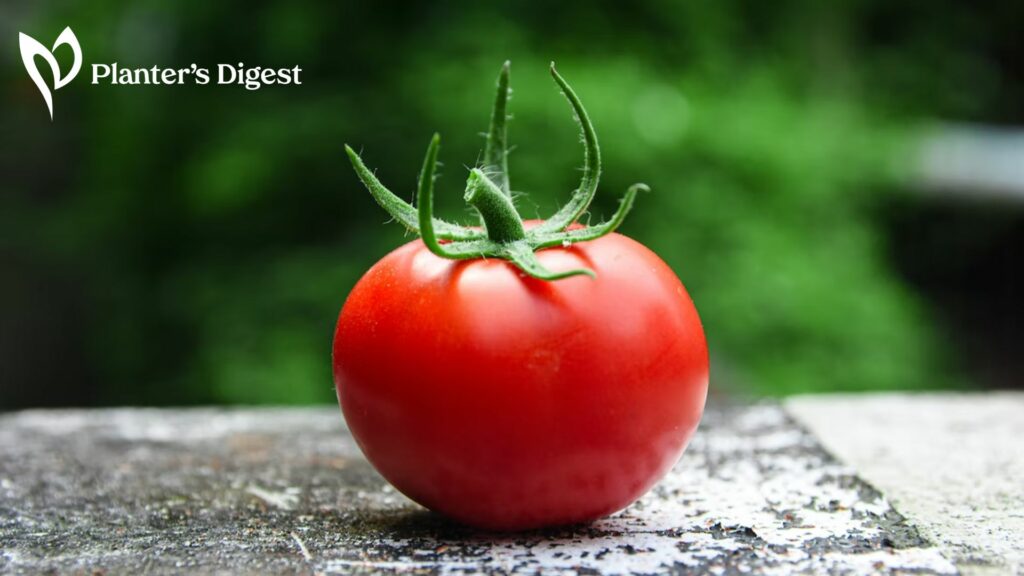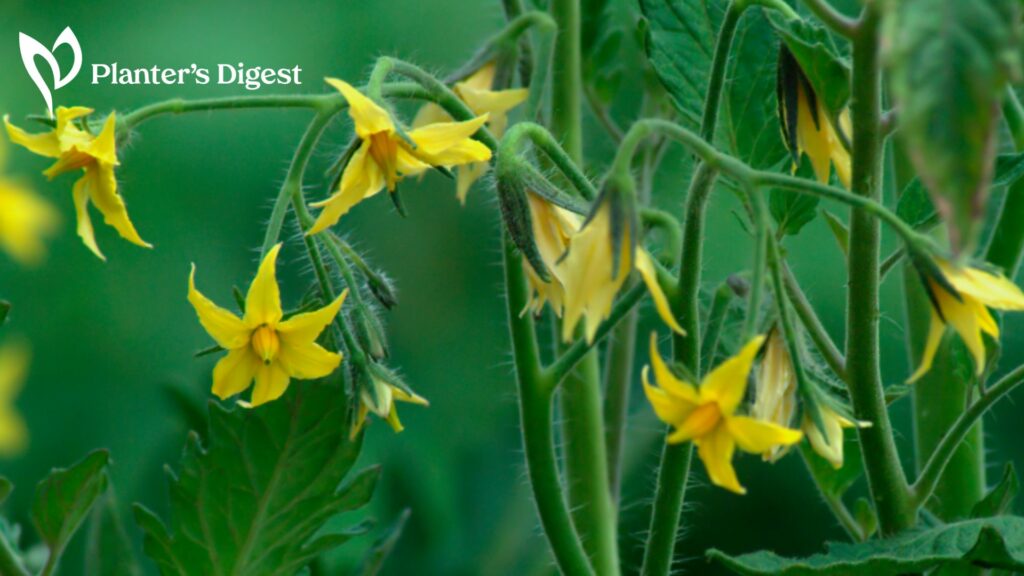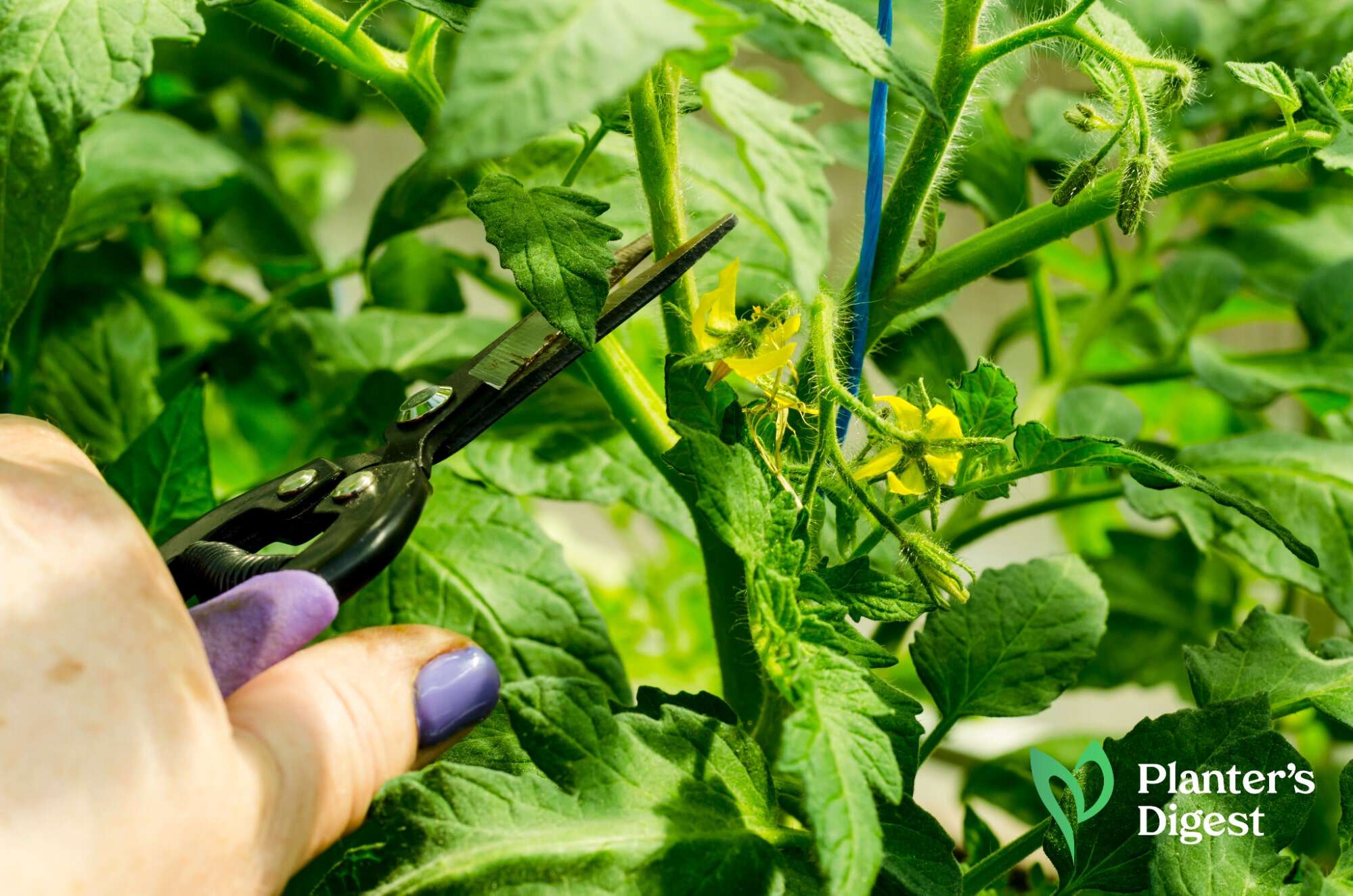
Are tomato suckers as annoying as their name suggests? Keep or remove? You’ve come to the right place, as we’ve got the answers to these questions!
In this article, we’ll walk you through everything you should know about tomato suckers and what to do with them.
What are tomato suckers?

Tomato suckers refer to the small side shoots that grow between a branch and the plant’s main stem. When left alone, these tomato suckers can grow their own branches, leaves and fruits, but the main plant will have dense growth.
As a result, you’ll get a bushy tomato plant that can increase the chances of spreading diseases and blocking the airflow around the tomato plant.
Why should you remove tomato suckers?
Tomato suckers must be removed because their absence will help the tomato plant produce larger and tastier fruits, speed up ripening, conserve space, and prevent plant diseases.
Let’s discuss each of these reasons.
1. Removing tomato suckers produce larger and tastier tomatoes.
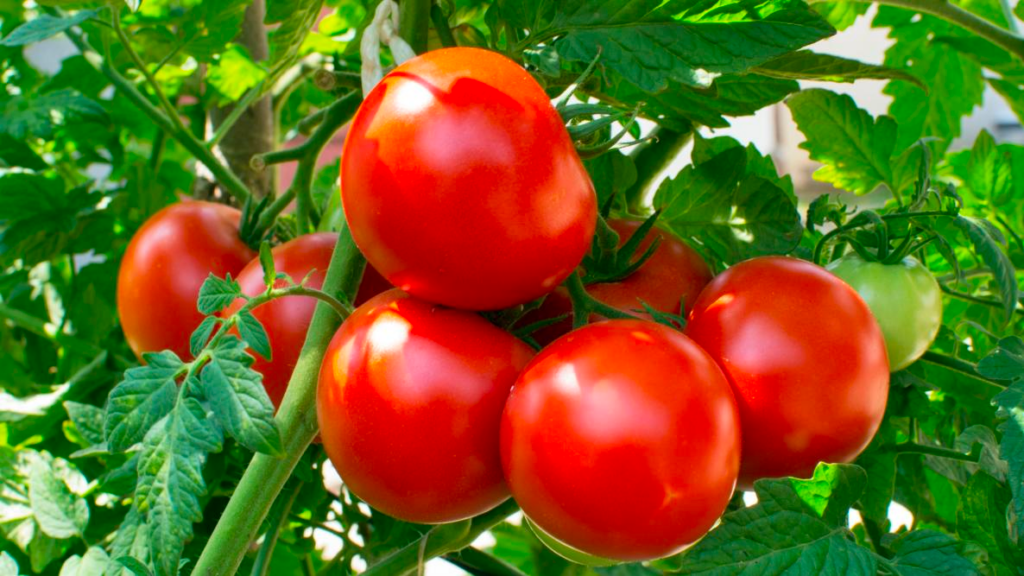
When you remove tomato suckers, the plant’s nutrients and energy are focused and directed only to producing fruits from the main tomato plant. As a result, you’ll be enjoying larger and tastier tomatoes come harvest season.
This is actually a common gardening practice backed by a study. It’s proven and tested that removing tomato suckers helped produce bigger fruits and protect the plant from diseases.
Also, when fewer leaves block tomatoes, the fruits get more sunlight, which helps them ripen and develop sugars. As a result, you’ll grow tastier tomatoes.
Removing tomato suckers is particularly recommended for indeterminate tomato plants because they continuously grow and produce fruits throughout the season.
2. Removing tomato suckers speeds up the ripening of tomatoes.
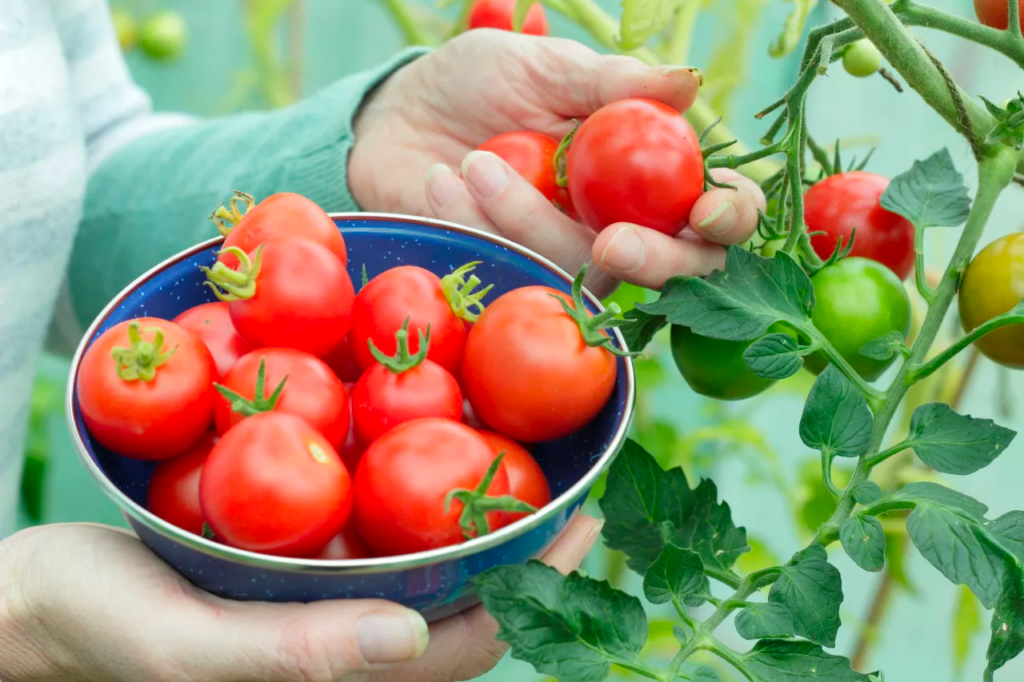
Tomato suckers are a distraction to the plant’s fruit production process. When these suckers emerge, the plant provides energy to these shoots to grow their new stems, leaves and fruits.
This leads to the main plant being deprived of energy that should be used for fruit production, taking more time for the tomatoes to ripen.
So, removing these suckers will help the plant re-direct its energy to produce tomatoes, faster ripening and earlier harvests.
3. Removing tomato suckers conserves space in your garden.

Pruning tomato suckers also helps reduce the plant’s overall size, giving you more space in your garden. This way, you’ll have more space to plant other tomato plants or species without their bushy growth.
This hack is best for planters who have limited gardening spaces in their home gardens. They make your tomato plant more manageable and ensure robust growth at the same time.
4. Removing tomato suckers prevent tomato plant diseases.

Removing tomato suckers prevents moisture build-up on the newly-grown stem and leaves.
Once these tomato suckers are removed, there will be more air circulation around the plant, allowing it to dry quickly after the rainfall or watering.
Less moisture reduces the growth of harmful bacteria and viruses that cause tomato plant diseases like early blight.
How should you remove tomato suckers?
Tomato suckers can be removed by hand or using pruning shears, depending on how big they have already grown. They should be removed as soon as you see them in your tomato plant.

| Difficulty | Easy ●○○○○ |
| Duration | 10 to 30 minutes |
| Things You Need | • Sanitized pruning shears |
For large tomato suckers, you can use sanitized pruning shears to avoid damaging and spreading disease to the tomato plant. Begin with removing suckers below the plant to avoid interfering with fruit development at the top.
As you prune your plant, you can also remove the low-lying or brown leaves to prevent the growth of harmful bacteria or the development of tomato plant diseases. Still, don’t over-prune because some leaves are needed to protect the tomato from sunscald.
| How To Do: 1. Look for tomato suckers that have already grown at least 2 inches. These are the small stem and leaves in the middle of the main stem and branch of the tomato plant. 2. Start by removing the tomato suckers below the plant, then work your way up. 3. Snap the tomato sucker by hand, or use sanitized pruning shears to remove them. 4. Make sure to leave enough leaves at the top of the plant to protect the fruits from sunscald. |
What to Do with Tomato Suckers
Tomato suckers aren’t a nuisance per se. In fact, there are beneficial ways to deal with tomato suckers, like using them to propagate new tomato plants, growing side shoots, or adding them to your compost or mulch.
1. Propagate new tomato plants.

| Difficulty | Easy ●○○○○ |
| Duration | 15 to 30 minutes for preparation7 to 10 days for rooting |
| Things You Need | • Pruning shears • Cup of water • Pot • Potting mix |
It may not be the end for tomato suckers. If you don’t want them to interfere with your plant, you can use them to grow new tomato plants through a process called “rooting.”
This is all made possible by the adventitious roots of tomatoes. This means that tomato suckers can grow roots anywhere along their stem.
In fact, if you see little bumps growing at the bottom of the stem, they’re actually roots waiting to come out. Scientifically, they’re called root primordia.
Here’s how to root or grow a new tomato plant out of a tomato sucker.
| How To Do: 1. Allow the tomato suckers to grow at least 6 inches. 2. Using a pruning shear, snap off the tomato sucker. 3. Place the stem end in a cup of water. Make sure that the leaves do not get wet to prevent them from rotting. 4. Place the container in a spot with indirect sunlight, and change the water every day. 5. After one week to 10 days, expect to see new white roots sprouting out of the stem. 6. Once the roots are about an inch long, transplant them into a pot with a moist potting mix and water them regularly. |
2. Grow tomato suckers as side shoots.
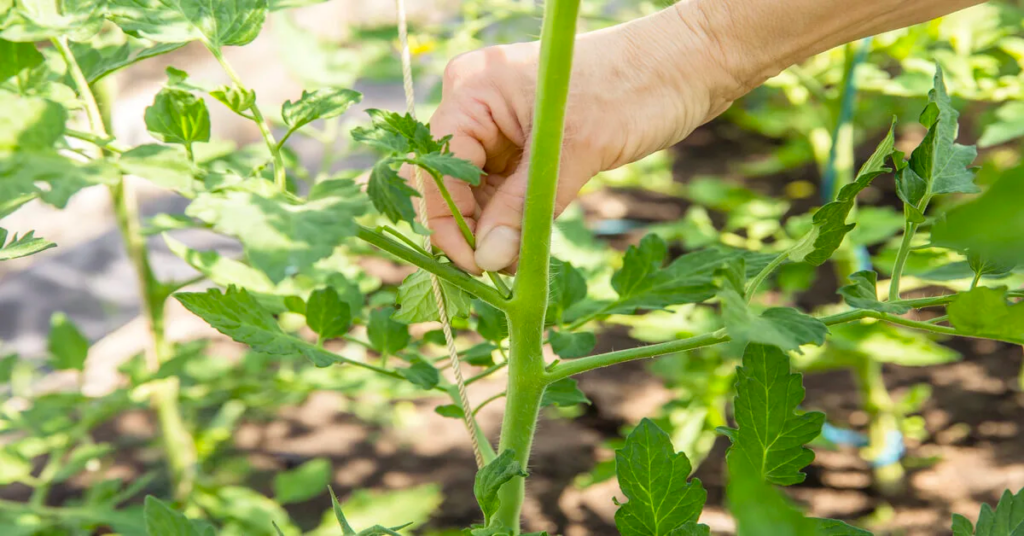
If you have a determinate tomato plant, such as Roma or celebrity tomatoes, it’s best to leave the tomato suckers to grow. Having more suckers means there will be more stems, flowers and fruits.
However, if you have an indeterminate tomato plant, like cherry, heirloom or beefsteak tomatoes, you can keep these side shoots but provide support for the vining growth of the plant.
You can use grow these indeterminate tomatoes using a wooden stake, trellis, wire cages or twines. Below are ways on how you can support your tomato plants.
1. Support your tomato plant using a wire cage.
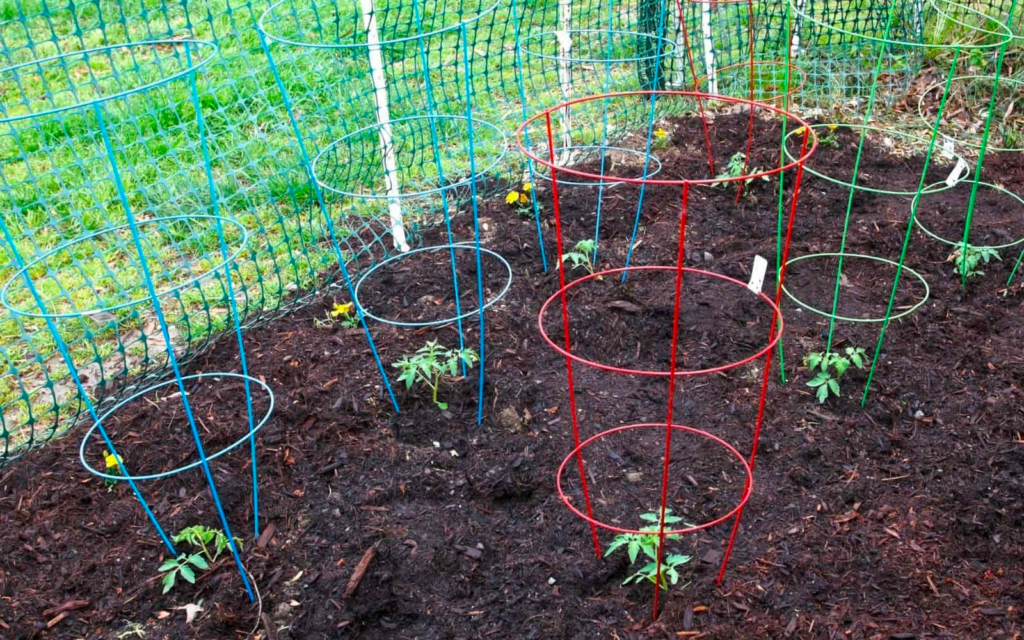
| Difficulty | Easy ●○○○○ |
| Duration | 1 to 2 hours |
| Things You Need | • Wire cage |
A wire cage allows the tomato vines to circle upwards, which helps maximize airflow within the plant and your garden.
When there is adequate air circulation, bacterial and fungal growth is kept at bay, lessening the risk for tomato plants to contract diseases.
Without a tomato cage, your tomato plant will spread on the ground and make itself susceptible to diseases, fruit rot, and pest attacks.
| How To Do: 1. With your cylindrical wire cage, make sure the mesh has holes at least 2 inches wide. 2. Place the wire cage around the tomato plant gently. 3. Drive a stake in the middle of the cage. Wrap the central stem around it for support. 4. Wrap each tomato vine on the sides of the cage using soft twine and yarn or string. |
2. Support your tomato plant using wooden stakes.

| Difficulty | Easy ●○○○○ |
| Duration | 1 to 2 hours |
| Things You Need | • Wooden stake • Wire, string or twine |
Wooden stakes are popular for training and supporting tomato plants in small spaces. You’ll just need to tie the tomato vines on a wooden stake and let it crawl over it.
Before tying your tomato vine, make sure to prune all the side branches and tomato suckers until you’re left with one main vine. Afterward, secure the main vine to the wooden stake using wire, string or twine.
| How To Do: 1. Prepare a wooden stake that measures 2 inches thick and 7 feet tall. Make sure the wood is not coated or treated to avoid contaminating the tomato plant or soil. 2. Drive the stake more than 1 foot into the ground. 3 Wrap the vines of the tomato plant loosely around the stake. |
3. Support your tomato plant using trellises.
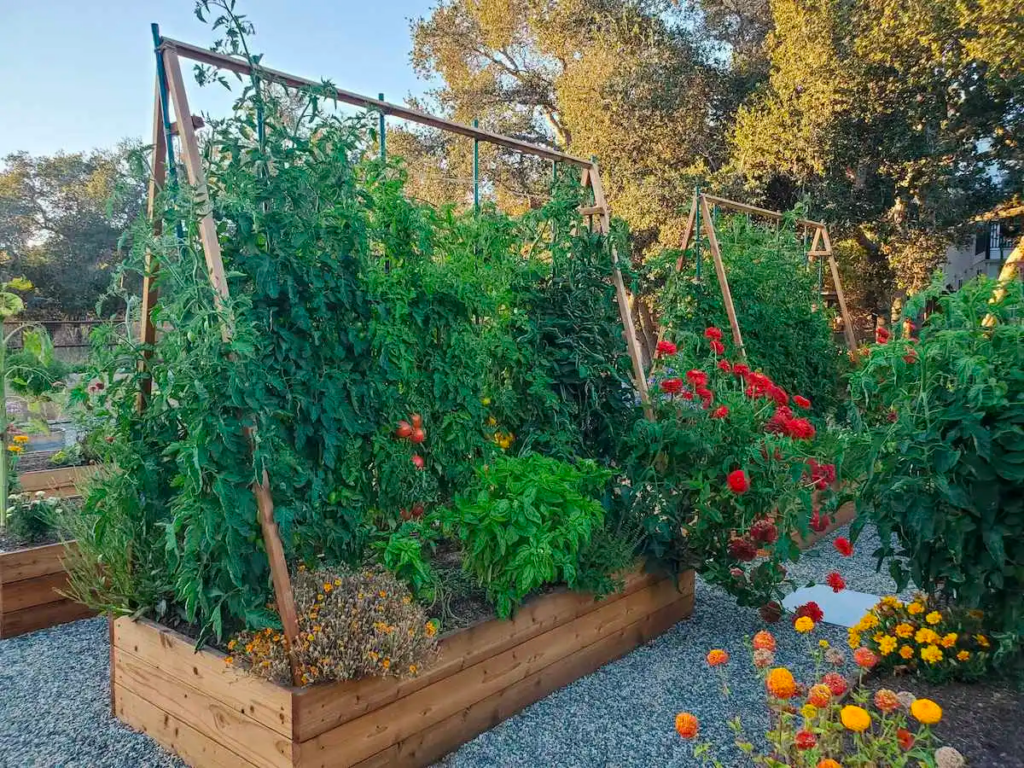
| Difficulty | Easy ●○○○○ |
| Duration | 1 to 2 hours |
| Things You Need | • Wooden stake • Wire, string or twine |
The trellis method is best for growing tomato plants in a row by “sandwiching” plants in between layers of string and holding them upright to support the tomato vines.
As the plants grow in the trellis, make sure to secure the tomato vines using a wire, soft twine or string.
| How To Do: 1. Use a wood or metal stake which is 6 to 8 feet high. 2. Drive in the wood or metal post every 10 to 15 feet within the row. 3. Connect the posts at the top using a strand of wire. 4. Attach one string above each tomato plant and leave it to fall naturally to the ground. 5. Wrap the tomato plant around the trellis using a soft twine, string or yarn. |
3. Use tomato suckers as compost or mulch.
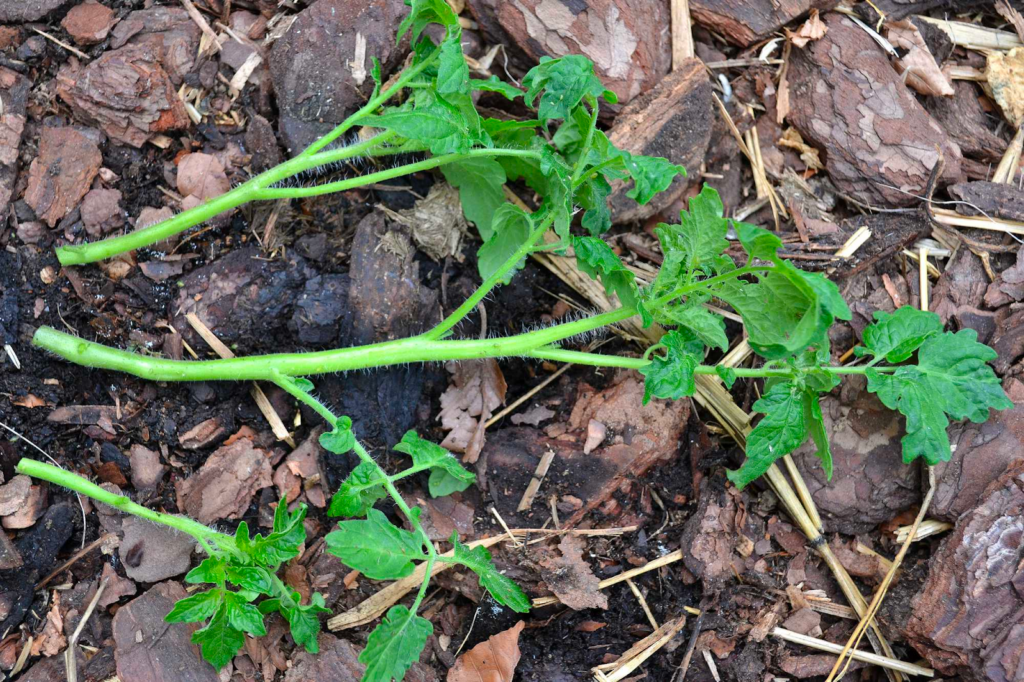
Tomato suckers and other plant cuttings can be used as compost or mulch for your tomato plant. This will help retain moisture in the soil and reduces the growth of weeds near the plant.
FAQs about Tomato Suckers
Removing tomato suckers reduces the plant’s overall size but helps produce larger and tastier tomatoes.
Tomato suckers cause the plant to produce smaller fruits as it competes with energy from the main plant. Additionally, the added leaves become a breeding ground for the growth of bacteria and viruses that cause tomato plant diseases.
All you need is sanitized pruning shears for tomato sucker removal because it helps prevent the spread of plant diseases and damage to the surrounding leaves and stems of the tomato plant.
Tomato side shoots, also known as tomato suckers, are small sprouts that emerge on the crotch of the stem and the main branch of the tomato plant.
Tomato shoots that are about 2 inches long can easily be pinched by hand, while longer tomato shoots can be removed using clean pruning shears.
Tomato suckers, or those small shoots in the middle of the branch and stem of the tomato plant, can be pinched off to redirect the plant’s energy into flower and fruit production.
To encourage a strong main stem, remove all tomato suckers below the first flower cluster of the tomato plant. This will help redirect all its nutrients and energy into the main plant and away from growing new stems and leaves from the tomato suckers.



